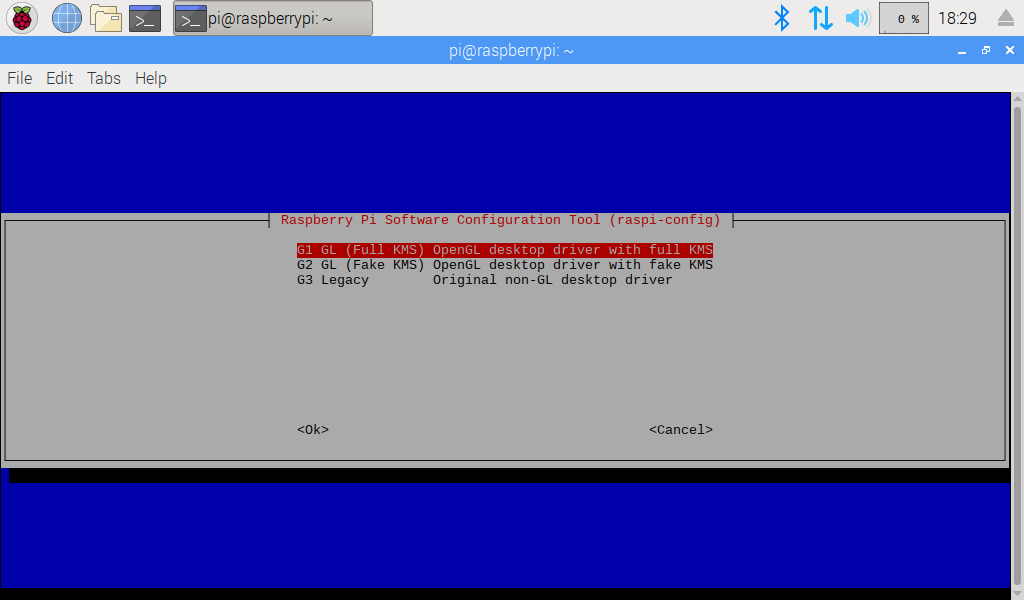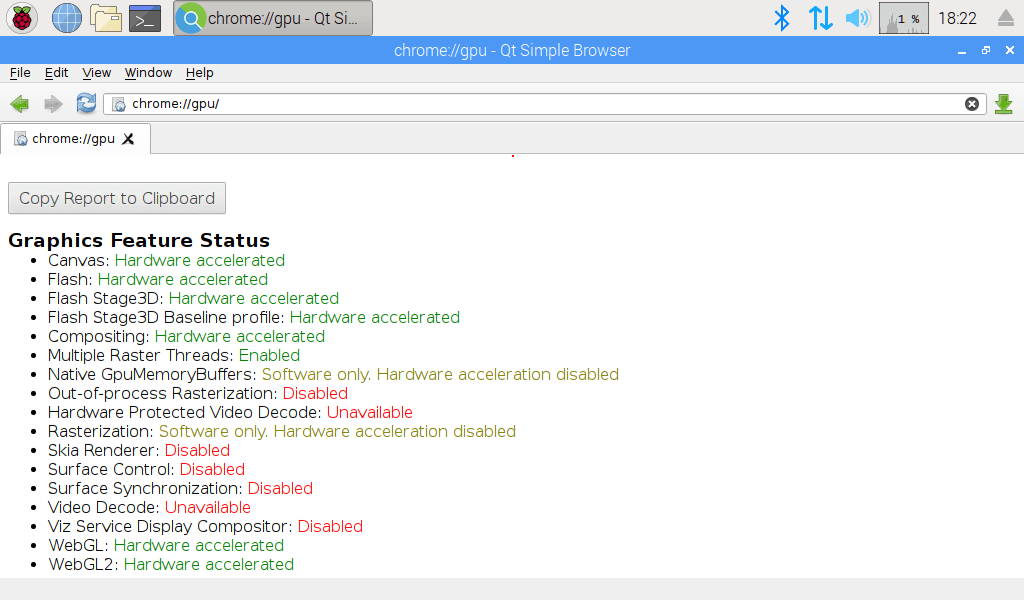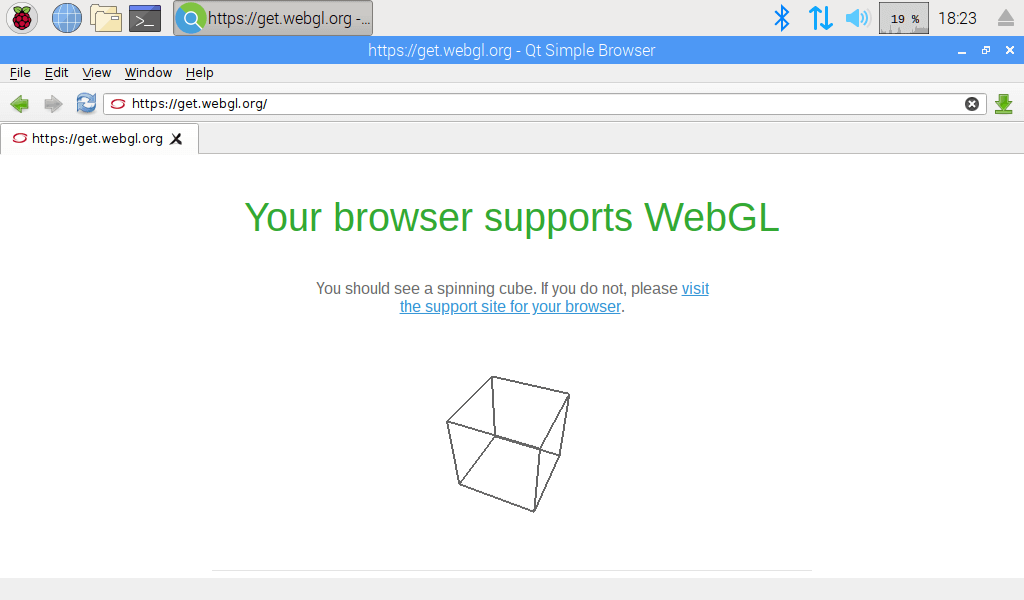RaspberryPiWithQt5WebEngine
This page describes how to set up self-compiled Qt5 WebEngine on Raspberry Pi 3 running Raspbian Stretch with WebGL support using VC4 open source drivers.
To see other guides visit:
- Qt5 general cross compilation guide for Raspbian with closed source drivers and the toolchain from Broadcom
- Qt6 WebEngine cross compilation guide for Raspberry Pi OS
- Qt6 general cross compilation guide for Raspberry Pi OS
Setup
The setup is tested on Rasberry Pi 3 model B. We'll use the latest open source VC4 Gallium3D driver instead of the old closed source binaries from Broadcom. We cannot use the Broadcom toolchain to compile Qt 5.13.2. and Qt WebEngine, because it uses the GCC compiler version 4.8, and we'll need at least version 5.0.
Raspbian Stretch ships with Binutils 2.28, GCC 6.3.0 and GlibC 2.24. Since we would like to use the same GlibC version and try to avoid running into a lot of issues when trying to compiler older GlibC 2.24 with newer GCC, we are going to simply mirror the Raspbian setup and reuse the same versions as Raspbian ships. Therefore we'll start with downloading the sources and Raspbian image.
- Let's create our workspace:
mkdir -p ~/workspaces/raspberrypi-raspbian/image mkdir -p ~/workspaces/raspberrypi-raspbian/toolchain/sources mkdir -p ~/workspaces/raspberrypi-raspbian/qt/qt5
- Let's now download archives:
cd ~/workspaces/raspberrypi-raspbian/image wget https://downloads.raspberrypi.org/raspbian/images/raspbian-2019-04-09/2019-04-08-raspbian-stretch.zip cd ~/workspaces/raspberrypi-raspbian/toolchain/sources wget https://ftpmirror.gnu.org/binutils/binutils-2.28.tar.bz2 wget https://ftpmirror.gnu.org/gcc/gcc-6.3.0/gcc-6.3.0.tar.gz tar xf gcc-6.3.0.tar.gz tar xf binutils-2.28.tar.bz2
Please note, most likely you would like to download the corresponding SHA1 to verify the archives.
Sysroot
To be able to compile things, we need a part of sysroot to be present on our build machine. As shown here, you could simply start your Raspbian on the board and then rsync required 'libs' and 'includes' to the host machine using the SSH connection. However, in this guide we will mount the image via a loop device, use qemu to install build dependencies and than make a local copy.
Note: We need actually a local copy of 'libs' and 'headers' from the image, as we want to adjust the symlinks.
- Let's extract the Raspbian image:
cd ~/workspaces/raspberrypi-raspbian/image unzip 2019-04-08-raspbian-stretch.zip
- We need add at least 2G space to the image to be able to fit qt build with debug info (see here instructions)
- Make loop devices for the image:
losetup -fP 2019-04-08-raspbian-stretch.img losetup -a /dev/loop0: []: (~/raspberrypi-raspbian/image/2019-04-08-raspbian-stretch.img)
- Mount the root partition:
mount /dev/loop0p2 -t ext4 /media/card mount --bind /dev /media/card/dev mount --bind /sys /media/card/sys mount --bind /proc /media/card/proc mount --bind /dev/pts /media/card/dev/pts
- We need qemu on the image to able to execute command, therefore copy static qemu binary to image.
cp /usr/bin/qemu-arm /media/card/usr/bin/
Note: Setup of qemu static interpreter is distribution specific. Please refer to your Linux distribution documentation.
- Chroot to sysroot and get qt5 build dependencies in:
cd /media/card/ chroot . bin/bash # uncomment the deb-src line vi /etc/apt/sources.list apt update apt install devscripts mk-build-deps libqt5gui5 apt install ./qtbase-opensource-src-build-deps_5.7.1+dfsg-3+rpi1+deb9u1_armhf.deb apt install libnss3 libnss3-dev exit
Note: We are going to use mk-build-deps to create dummy package, so we can uninstall dependencies when no longer needed.
- rsync the parts that we need:
cd ~/workspaces/raspberrypi-raspbian rsync -av /media/card/lib sysroot rsync -av /media/card/usr/include sysroot/usr rsync -av /media/card/usr/lib sysroot/usr
- Adjust symlinks to be relative:
wget https://raw.githubusercontent.com/Kukkimonsuta/rpi-buildqt/master/scripts/utils/sysroot-relativelinks.py chmod +x sysroot-relativelinks.py ./sysroot-relativelinks.py sysroot
- Cleanup image (optional)
cd /media/card/ chroot . bin/bash apt remove devscripts qtbase-opensource-src-build-deps libnss3-dev apt autoremove apt clean exit
- Umount no longer needed mounts:
umount /media/card/sys /media/card/proc /media/card/dev/pts /media/card/dev
- Detach loop device:
losetup -d /dev/loop0
Toolchain
To compile Qt, we need a cross-compiler toolchain. There are many excellent tools to compile a toolchain, such as crosstool-ng or buildroot. However, we choose to compile GCC from scratch. Compiling a compiler is a bit tricky and includes a few tasks:
- Installing Linux headers that are required to make system calls from the C library and to compile it
- Building biuntils to get a cross-linker, a cross-assembler, and some other tools using your host compiler
- Building the first stage GCC (bootstrapping), to have a basic compiler with C language support and static linking
- Building the C library using the first stage compiler
- Building a second stage GCC, which uses the C library, supports dynamic linking and the C++ language
We already have GlibC compiled in our sysroot shipped by Rasbian, so we are going to cheat here a bit and skip the bootstrapping of GCC and the building of GlibC itself. We can simply use sysroot directly and just compile the linker, the assembler and final cross-compiler.
- Let's do initial setup:
export WORKSPACE_ROOT=~/workspaces/raspberrypi-raspbian/toolchain export PREFIX=${WORKSPACE_ROOT}/toolchain export TARGET=arm-linux-gnueabihf export SYSROOT=${WORKSPACE_ROOT}/../sysroot export PATH=${PREFIX}/bin:$PATH mkdir -p ${PREFIX} cd ${WORKSPACE_ROOT}
- Let's build the linker and assembler:
mkdir -p build/binutils pushd build/binutils ../../sources/binutils-2.28/configure --target=${TARGET} --prefix=${PREFIX} --with-arch=armv6 --with-fpu=vfp --with-float=hard --disable-multilib make -j12 make install popd
- We need additional GMP, MPFR and MPC libraries to be able to build GCC. This can be easily set up by running script in the GCC source directory.
cd ~/workspaces/raspberrypi-raspbian/toolchain/sources/gcc-6.3.0 contrib/download_prerequisites
- Let's now build GCC:
mkdir -p build/gcc2 pushd build/gcc2 ../../sources/gcc-6.3.0/configure --prefix=${PREFIX} --target=${TARGET} --with-sysroot=${SYSROOT} --enable-languages=c,c++ --disable-multilib --enable-multiarch --with-arch=armv6 --with-fpu=vfp --with-float=hard make -j12 make install popd
Note that I got a compiler error, so you might have to edit raspberrypi-raspbian/toolchain/sources/gcc-6.3.0/gcc/ubsan.c line 1474 and change it to:
|| xloc.file[0] == '\0' || xloc.file[0] == '\xff'
Compiling Qt
As shown here, we could do a top level build of Qt, but we are going to do prefix module builds just to show an alternative way of building Qt. We need three repositories to have Qt WebEngine up and running: qtbase, qtdeclarative and qtwebengine. It is important to configure Qt with linux-rasp-pi3-vc4-g++ device, since this spec contains newer vc4 OpenGL drivers. We also compile two back-ends for QPA: xcb to run it in the Rasbian window manager and eglfs to run as a full-screen single-window application.
- Let's configure qtbase, compile it and install it:
cd ~/workspaces/raspberrypi-raspbian/qt/qt5 git clone git://code.qt.io/qt/qtbase.git git checkout 5.13.1 mkdir -p ~/workspaces/raspberrypi-raspbian/qt/build/qtbase cd ~/workspaces/raspberrypi-raspbian/qt/build/qtbase ~/workspaces/qt/qt5/qtbase/configure -release -opengl es2 -device linux-rasp-pi3-vc4-g++ \ -device-option CROSS_COMPILE=~/workspaces/raspberrypi-raspbian/toolchain/toolchain/bin/arm-linux-gnueabihf- \ -opensource -confirm-license -nomake tests -nomake examples -verbose -no-pch -eglfs -xcb \ -sysroot /home/stefan/workspaces/raspberrypi-raspbian/sysroot \ -prefix /usr/local/qt/5.13 \ -extprefix /opt/qt/5.13/raspbian/sysroot \ -hostprefix /opt/qt/5.13/raspbian make make install
- Compile qtdeclarative and install it:
cd ~/workspaces/raspberrypi-raspbian/qt/qt5 git clone git://code.qt.io/qt/qtdeclarative.git git checkout 5.13.1 mkdir -p ~/workspaces/raspberrypi-raspbian/qt/build/qtdeclarative cd ~/workspaces/qt/build/qtdeclarative /opt/qt/5.13/raspbian/bin/qmake ~/workspaces/qt/qt5/qtdeclarative make make install
- Compile qtwebengine and install it:
cd ~/workspaces/raspberrypi-raspbian/qt/qt5 git clone git://code.qt.io/qt/qtwebengine.git git submodule init git checkout 5.13.1 git submodule update mkdir -p ~/workspaces/raspberrypi-raspbian/qt/build/qtwebengine cd ~/workspaces/raspberrypi-raspbian/qt/build/qtwebengine /opt/qt/5.13/raspbian/bin/qmake ~/workspaces/qt/qt5/qtwebengine -- --no-feature-webengine-arm-thumb make make install
- Compile the Simple Browser example:
mkdir -p ~/workspaces/raspberrypi-raspbian/qt/build/simplebrowser cd ~/workspaces/raspberrypi-raspbian/qt/build/simplebrowser /opt/qt/5.13/raspbian/bin/qmake ~/workspaces/qt/qt5/qtwebengine/examples/webenginewidgets/simplebrowser make
Deploy
We still have our image mounted form the sysroot step. If you chose to rsync sysroot over the network, just replace the rsync steps below with the equivalent network location of your Rasberry Pi board.
- Deploy with rsync
mkdir -p /media/card/usr/local/qt/5.13 rsync -av /opt/qt/5.13/raspbian/sysroot/ /media/card/usr/local/qt/5.13 cp ~/workspaces/raspberrypi-raspbian/qt/build/simplebrowser/simplebrowser /media/card/usr/local/bin/
- Unmount the image
umount /media/card
- Copy the image to the SD card (replace sdX with the device on your machine):
cd ~/workspaces/raspberrypi-raspbian/image dd if=2019-04-08-raspbian-stretch.img of=/dev/sdX bs=4M
- Boot the image up, and switch to enable OpenGL (Full KMS):
raspi-config
- Fix run-time linker search paths
echo /usr/local/qt/5.13/lib > /etc/ld.so.conf.d/00-qt.5.13.conf ldconfig
- Reboot
- To run Simple Browser within Raspbian Desktop (former PIXEL Desktop) open console or SSH:
export DISPLAY=:0 export QTWEBENGINE_DISABLE_GPU_THREAD=1 /usr/local/bin/simplebrowser -platform xcb
- Navigate to chrome://gpu/, and you should see:
- Navigate to https://get.webgl.org/, and you should see:
- To run without x11 , SSH to the device and shut down the login manager:
systemctl stop lightdm export QTWEBENGINE_DISABLE_GPU_THREAD=1 /usr/local/bin/simplebrowser -platform eglfs


